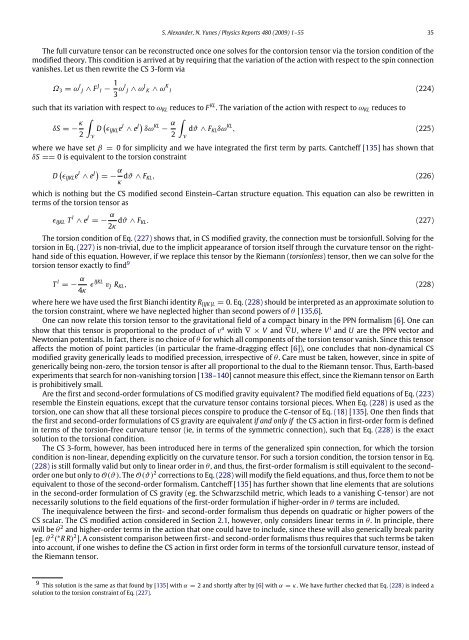Physics Reports ChernâSimons modified general relativity
Physics Reports ChernâSimons modified general relativity
Physics Reports ChernâSimons modified general relativity
Create successful ePaper yourself
Turn your PDF publications into a flip-book with our unique Google optimized e-Paper software.
S. Alexander, N. Yunes / <strong>Physics</strong> <strong>Reports</strong> 480 (2009) 1–55 35The full curvature tensor can be reconstructed once one solves for the contorsion tensor via the torsion condition of the<strong>modified</strong> theory. This condition is arrived at by requiring that the variation of the action with respect to the spin connectionvanishes. Let us then rewrite the CS 3-form viaΩ 3 = ω I J ∧ F J I − 1 3 ωI J ∧ ω J K ∧ ω K I (224)such that its variation with respect to ω KL reduces to F KL . The variation of the action with respect to ω KL reduces toδS = − κ ∫( D ɛ IJKL e I ∧ e J) δω KL − α ∫dϑ ∧ F KL δω KL , (225)2 V 2 Vwhere we have set β = 0 for simplicity and we have integrated the first term by parts. Cantcheff [135] has shown thatδS == 0 is equivalent to the torsion constraintD ( ɛ IJKL e I ∧ e J) = − α κ dϑ ∧ F KL, (226)which is nothing but the CS <strong>modified</strong> second Einstein–Cartan structure equation. This equation can also be rewritten interms of the torsion tensor asɛ IJKL T I ∧ e J = − α 2κ dϑ ∧ F KL. (227)The torsion condition of Eq. (227) shows that, in CS <strong>modified</strong> gravity, the connection must be torsionfull. Solving for thetorsion in Eq. (227) is non-trivial, due to the implicit appearance of torsion itself through the curvature tensor on the righthandside of this equation. However, if we replace this tensor by the Riemann (torsionless) tensor, then we can solve for thetorsion tensor exactly to find 9T I = − α 4κ ɛIJKL v J R KL , (228)where here we have used the first Bianchi identity R [IJK]L = 0. Eq. (228) should be interpreted as an approximate solution tothe torsion constraint, where we have neglected higher than second powers of θ [135,6].One can now relate this torsion tensor to the gravitational field of a compact binary in the PPN formalism [6]. One canshow that this tensor is proportional to the product of v a with ∇ × V and ⃗∇U, where V i and U are the PPN vector andNewtonian potentials. In fact, there is no choice of θ for which all components of the torsion tensor vanish. Since this tensoraffects the motion of point particles (in particular the frame-dragging effect [6]), one concludes that non-dynamical CS<strong>modified</strong> gravity generically leads to <strong>modified</strong> precession, irrespective of θ. Care must be taken, however, since in spite ofgenerically being non-zero, the torsion tensor is after all proportional to the dual to the Riemann tensor. Thus, Earth-basedexperiments that search for non-vanishing torsion [138–140] cannot measure this effect, since the Riemann tensor on Earthis prohibitively small.Are the first and second-order formulations of CS <strong>modified</strong> gravity equivalent? The <strong>modified</strong> field equations of Eq. (223)resemble the Einstein equations, except that the curvature tensor contains torsional pieces. When Eq. (228) is used as thetorsion, one can show that all these torsional pieces conspire to produce the C-tensor of Eq. (18) [135]. One then finds thatthe first and second-order formulations of CS gravity are equivalent if and only if the CS action in first-order form is definedin terms of the torsion-free curvature tensor (ie, in terms of the symmetric connection), such that Eq. (228) is the exactsolution to the torsional condition.The CS 3-form, however, has been introduced here in terms of the <strong>general</strong>ized spin connection, for which the torsioncondition is non-linear, depending explicitly on the curvature tensor. For such a torsion condition, the torsion tensor in Eq.(228) is still formally valid but only to linear order in θ, and thus, the first-order formalism is still equivalent to the secondorderone but only to O(ϑ). The O(ϑ) 2 corrections to Eq. (228) will modify the field equations, and thus, force them to not beequivalent to those of the second-order formalism. Cantcheff [135] has further shown that line elements that are solutionsin the second-order formulation of CS gravity (eg. the Schwarzschild metric, which leads to a vanishing C-tensor) are notnecessarily solutions to the field equations of the first-order formulation if higher-order in θ terms are included.The inequivalence between the first- and second-order formalism thus depends on quadratic or higher powers of theCS scalar. The CS <strong>modified</strong> action considered in Section 2.1, however, only considers linear terms in θ. In principle, therewill be θ 2 and higher-order terms in the action that one could have to include, since these will also generically break parity[eg. ϑ 2 ( ∗ R R) 2 ]. A consistent comparison between first- and second-order formalisms thus requires that such terms be takeninto account, if one wishes to define the CS action in first order form in terms of the torsionfull curvature tensor, instead ofthe Riemann tensor.9 This solution is the same as that found by [135] with α = 2 and shortly after by [6] with α = κ. We have further checked that Eq. (228) is indeed asolution to the torsion constraint of Eq. (227).



![arXiv:1001.0993v1 [hep-ph] 6 Jan 2010](https://img.yumpu.com/51282177/1/190x245/arxiv10010993v1-hep-ph-6-jan-2010.jpg?quality=85)


![arXiv:1008.3907v2 [astro-ph.CO] 1 Nov 2011](https://img.yumpu.com/48909562/1/190x245/arxiv10083907v2-astro-phco-1-nov-2011.jpg?quality=85)







![arXiv:1002.4928v1 [gr-qc] 26 Feb 2010](https://img.yumpu.com/41209516/1/190x245/arxiv10024928v1-gr-qc-26-feb-2010.jpg?quality=85)
![arXiv:1206.2653v1 [astro-ph.CO] 12 Jun 2012](https://img.yumpu.com/39510078/1/190x245/arxiv12062653v1-astro-phco-12-jun-2012.jpg?quality=85)
